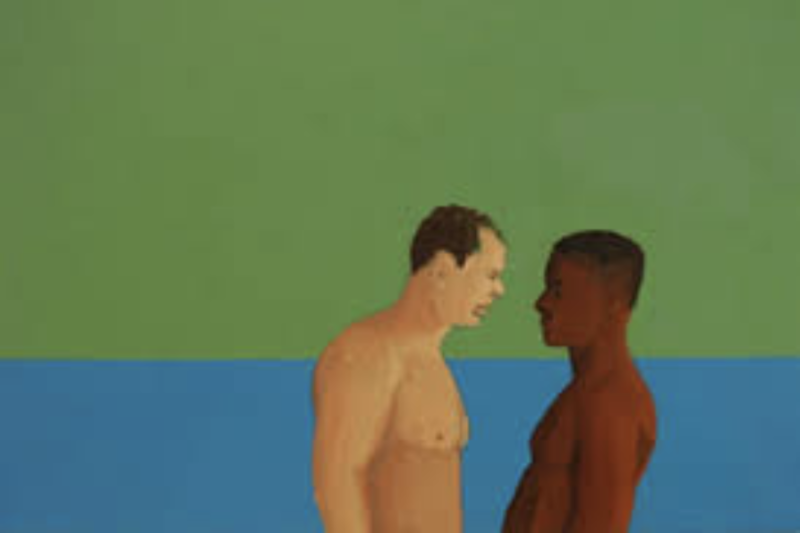The Treadmill
Posted by admin on

By Anne Freeman
I prefer to use the west entrance, where I don’t have to pass through revolving doors, a guaranteed disaster.
There’s a lineup waiting to get past the pandemic interrogators, and I’m already late. Blustery weather and traffic lights almost always stall me, and this morning, nothing is cooperating. I silently remind myself not to hurry; rushing is another sure-fire way of asking for trouble. Once I’ve answered the same questions the guardians ask on every single visit, I pull on a new mask and make my way across the atrium, balking just a few times. Luckily, I don’t (quite) fall getting into the elevator, which makes up for some of the time I lost trying to get here.
The doors open on the top floor and I text Karl to let me into the labs. I am out of breath, and I stick and stumble trying to enter. He offers a welcoming chair, creamy yellow and soft, and asks if today is more difficult than usual. I reply that it isn’t; an almost endless list of things can cause me to freeze. Freezing of gait, or FOG, is Karl’s area of specialization, and this room, with its huge screen and special treadmill, is devoted to researching the phenomenon.
We fill out forms. I answer questions that reveal the humiliations, limitations and defeats in the past month of my life with Parkinson’s Disease. After almost 12 years, two brain surgeries and countless prescriptions, I have no reason to expect anything miraculous from Karl’s project, but increasing bouts of freezing and the resulting falls have me battling a fear that each day could be my last. So, here I am.
On the table beside us is a tray of shiny, little plastic orbs with a light inside each. Matching pairs must be stuck like burrs on shoes, knees, pelvis, chest and neck to make my glowing avatar dance upon the computer monitor. I admit I want to slip some in my pocket and take them home, to make something amusing from this day.
Then I step into the harness, all buckles and straps and clinking metal. Karl adjusts the fit and then asks me to climb the steps onto the treadmill. With sturdy chains behind my back, he hooks me to a hidden beam in the ceiling. I imagine myself as a draft horse, a prisoner, a circus performer, wondering if I could swing from the rafters or be dragged to my death.
I think we must be about to start, but Karl unhooks the harness and asks me to step off the machine and sit down again. “Wait,” he says, “I have to power off the force plates.” This is my favourite line of the day. “Beam me up!” I feel like shouting, “Ready to teleport!” but there are no wondrous changes yet.
Next, he turns off the lights, climbs onto the treadmill, and waves a cross-like tool studded with ruby-coloured lights in graceful figure eights over the equipment. We are somewhere between an airport landing strip and a wizard’s den. Is he blessing the experiment with spells and prayers, calling out the magic within the machine?
I am eager for magic, but the final step is calibration.
I am eager for magic, but the final step is calibration. Obediently, I ascend the steps again and stretch my arms out like Leonardo’s Man, trying to remain patient while Karl measures and checks every detail. This isn’t just any treadmill. It’s split down the middle so the two sides can run at different speeds, someone’s clever idea of how to retrain off-kilter brains.
At last, it is time to begin! Karl takes his seat at the computer monitors just behind my field of vision and describes the kinds of challenges I am about to face, one after another in random order. “Surprise me,” I tell him in a moment of brash confidence. After confirming once more that I am totally ready, we get started.
Grey lights, red lights, green means go! I focus my full attention on the enormous screen and try to walk normally, swinging my arms and following the instructions that appear like subtitles when the treadmill starts moving beneath my feet.
But what unmagical world is this?
I see a most unstonelike wall, interrupted by crudely drawn cutouts representing narrow doorways. There are shapes like lecterns on each side, with strange patterns imitating lichens pasted onto them. Frothy dabs pretend they’re trees.
Problems for me to answer flash upon the screen: 38+27, 3×41.
Name yellow though the word is blue; call out red not acid green.
I pass through many cardboard cutout doorways and emerge onto a bridge with no railings that is supposed to be high above the artificial pastures below. Wisps of virtual reality dry ice slip out from behind obstacles along the path.
Now the treadmill makes my steps uneven. One foot moves faster or slower than the other, and I stagger like a would-be dancer who wasn’t taught the choreography before the show.
For 12 rounds he tries to make me freeze, hoping to replicate my crash-filled days here in the cool, clean calibrated darkness of the lab, so he can understand why people like me are dragged round and round in revolving doors; why it can take 10 excruciating minutes to cross a hall in order to welcome a friend at the door; why our knees and elbows are perpetually bruised from falling while the phone keeps ringing, unanswered; why the light turning green and the walk signal showing a purposeful pedestrian are not enough to allow us to cross the street.
But never once do I fall. I trudge through every challenge unperturbed, although I expect gargoyles to leap out at any moment. I don’t fall off the bridge and land on the purplish lumps representing sheep down below, and I don’t find a holy grail of any sort.
I am sorry to let Karl down. He wants so much to unlock the stubborn fault inside brains like mine. We count the sticky orbs as we pull them off my clothing without saying much. I re-tie my shoes and he leads me to the exit.
The elevator arrives at the top floor. “Call me again if you have more ideas to test,” I say, and when the doors open, I freeze and then lurch inside, managing to seize the handrail before I hit the deck. A wave of embarrassment and fear rises in my throat but I leave the hospital with no further incidents.
It is windy outside, and I don’t make it across at the intersection until I’ve missed several changes of the lights. I try to walk normally, swinging my arms, despite being surrounded by menacing objects. The curbs are treacherous and every light post threatens to tip me over.
Eventually, I find my way to a quiet alley and begin the uncertain walk home.
Illustrations courtesy of Anne Freeman.
Editor’s postscript: Anne’s condition has improved recently after the team at the UHN Mobility Disorder Clinic adjusted her treatment. “Life with PD is full of surprises, and it isn’t entirely a one-way journey!” she says.
—
This post was previously published on HEALTHYDEBATE.CA and is republished under a Creative Commons license.
***
You may also like these posts on The Good Men Project:
 White Fragility: Talking to White People About Racism White Fragility: Talking to White People About Racism |
 Escape the “Act Like a Man” Box Escape the “Act Like a Man” Box |
 Why I Don’t Want to Talk About Race Why I Don’t Want to Talk About Race |
 What We Talk About When We Talk About Men What We Talk About When We Talk About Men |
Join The Good Men Project as a Premium Member today.
All Premium Members get to view The Good Men Project with NO ADS.
A $50 annual membership gives you an all access pass. You can be a part of every call, group, class and community.
A $25 annual membership gives you access to one class, one Social Interest group and our online communities.
A $12 annual membership gives you access to our Friday calls with the publisher, our online community.
Register New Account
Log in if you wish to renew an existing subscription.
Need more info? A complete list of benefits is here.
—
Photo credit: Intenza Fitness on Unsplash.com
The post The Treadmill appeared first on The Good Men Project.
